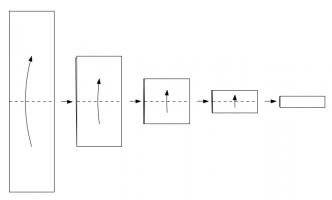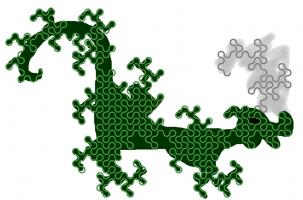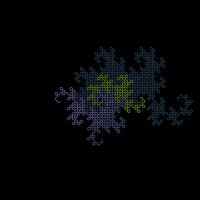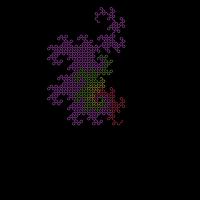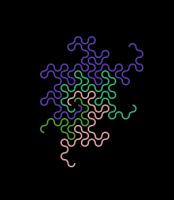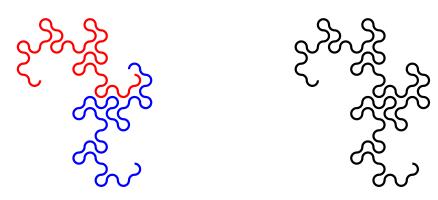Blog
2016-03-30
Take a piece of paper. Fold it in half in the same direction many times. Now unfold it. What pattern will the folds make?
I first found this question in one of Martin Gardner's books. At first, you might that the answer will be simple, but if you look at the shapes made for a few folds, you will see otherwise:
The curves formed are called dragon curves as they allegedly look like dragons with smoke rising from their nostrils. I'm not sure I see the resemblance:
As you increase the order of the curve (the number of times the paper was folded), the dragon curve squiggles across more of the plane, while never crossing itself. In fact, if the process was continued forever, an order infinity dragon curve would cover the whole plane, never crossing itself.
This is not the only way to cover a plane with dragon curves: the curves tessellate.
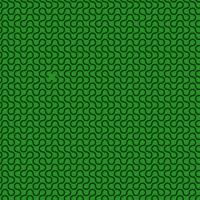
When tiled, this picture demonstrates how dragon curves tessellate. For a demonstration, try obtaining infinite lives...
Dragon curves of different orders can also fit together:
To generate digital dragon curves, first notice that an order \(n\) curve can be made from two order \(n-1\) curves:
This can easily be seen to be true if you consider folding paper: If you fold a strip of paper in half once, then \(n-1\) times, each half of the strip will have made an order \(n-1\) dragon curve. But the whole strip has been folded \(n\) times, so is an order \(n\) dragon curve.
Because of this, higher order dragons can be thought of as lots of lower order dragons tiled together. An the infinite dragon curve is actually equivalent to tiling the plane with a infinite number of dragons.
If you would like to create your own dragon curves, you can download the Python code I used to draw them from GitHub. If you are more of a thinker, then you might like to ponder what difference it would make if the folds used to make the dragon were in different directions.
(Click on one of these icons to react to this blog post)
You might also enjoy...
Comments
Comments in green were written by me. Comments in blue were not written by me.
Add a Comment
2015-08-29
A few weeks ago, I made OEISbot, a Reddit bot which posts information whenever an OEIS sequence is mentioned.
This post explains how OEISbot works. The full code can be found on GitHub.
Getting started
OEISbot is made in Python using PRAW (Python Reddit Api Wrapper). PRAW can be installed with:
bash
pip install prawBefore making a bot, you will need to make a Reddit account for your bot, create a Reddit app and obtain API keys. This python script can be used to obtain the necessary keys.
Once you have your API keys saved in your praw.ini file, you are ready to make a bot.
Writing the bot
First, the necessary imports are made, and test mode is activated if the script is run with test as an argument. We also define an exception that will be used later to kill the script once it makes a comment.
python
import prawimport re
import urllib
import json
from praw.objects import MoreComments
import sys
test = False
if len(sys.argv) > 1 and sys.argv[1] == "test":
test = True
print("TEST MODE")
class FoundOne(BaseException):
pass
To prevent OEISbot from posting multiple links to the same sequence in a thread, lists of sequences linked to in each thread can be loaded and saved using the following functions.
python
def save_list(seen, _id):print(seen)
with open("/home/pi/OEISbot/seen/"+_id, "w") as f:
return json.dump(seen, f)
def open_list(_id):
try:
with open("/home/pi/OEISbot/seen/" + _id) as f:
return json.load(f)
except:
return []
The following function will search a post for a mention of an OEIS sequence number.
python
def look_for_A(id_, text, url, comment):seen = open_list(id_)
re_s = re.findall("A([0-9]{6})", text)
re_s += re.findall("oeis\.org/A([0-9]{6})", url)
if test:
print(re_s)
post_me = []
for seq_n in re_s:
if seq_n not in seen:
post_me.append(markup(seq_n))
seen.append(seq_n)
if len(post_me) > 0:
post_me.append(me())
comment(joiner().join(post_me))
save_list(seen, id_)
raise FoundOne
The following function will search a post for a comma-separated list of numbers, then search for it on the OEIS. If there are 14 sequences or less found, it will reply. If it finds a list with no matches on the OEIS, it will message /u/PeteOK, as he likes hearing about possibly new sequences.
python
def look_for_ls(id_, text, comment, link, message):seen = open_list(id_)
if test:
print(text)
re_s = re.findall("([0-9]+\, *(?:[0-9]+\, *)+[0-9]+)", text)
if len(re_s) > 0:
for terms in ["".join(i.split(" ")) for i in re_s]:
if test:
print(terms)
if terms not in seen:
seen.append(terms)
first10, total = load_search(terms)
if test:
print(first10)
if len(first10)>0 and total <= 14:
if total == 1:
intro = "Your sequence (" + terms \
+ ") looks like the following OEIS sequence."
else:
intro = "Your sequence (" + terms + \
+ ") may be one of the following OEIS sequences."
if total > 4:
intro += " Or, it may be one of the " + str(total-4) \
+ " other sequences listed [here]" \
"(http://oeis.org/search?q=" + terms + ")."
post_me = [intro]
if test:
print(first10)
for seq_n in first10[:4]:
post_me.append(markup(seq_n))
seen.append(seq_n)
post_me.append(me())
comment(joiner().join(post_me))
save_list(seen, id_)
raise FoundOne
elif len(first10) == 0:
post_me = ["I couldn't find your sequence (" + terms \
+ ") in the [OEIS](http://oeis.org). "
"You should add it!"]
message("PeteOK",
"Sequence not in OEIS",
"Hi Peter, I've just found a new sequence (" \
+ terms + ") in [this thread](link). " \
"Please shout at /u/mscroggs to turn the " \
"feature off if its spamming you!")
post_me.append(me())
comment(joiner().join(post_me))
save_list(seen, id_)
raise FoundOne
def load_search(terms):
src = urllib.urlopen("http://oeis.org/search?fmt=data&q="+terms).read()
ls = re.findall("href=(?:'|\")/A([0-9]{6})(?:'|\")", src)
try:
tot = int(re.findall("of ([0-9]+) results found", src)[0])
except:
tot = 0
return ls, tot
The markup function loads the necessary information from OEIS and formats it. Each comment will end with the output of the me function. The ouput of joiner will be used between sequences which are mentioned.
python
def markup(seq_n):pattern = re.compile("%N (.*?)<", re.DOTALL|re.M)
desc = urllib.urlopen("http://oeis.org/A" + seq_n + "/internal").read()
desc = pattern.findall(desc)[0].strip("\n")
pattern = re.compile("%S (.*?)<", re.DOTALL|re.M)
seq = urllib.urlopen("http://oeis.org/A" + seq_n + "/internal").read()
seq = pattern.findall(seq)[0].strip("\n")
new_com = "[A" + seq_n + "](http://oeis.org/A" + seq_n + "/): "
new_com += desc + "\n\n"
new_com += seq + "..."
return new_com
def me():
return "I am OEISbot. I was programmed by /u/mscroggs. " \
"[How I work](http://mscroggs.co.uk/blog/20). " \
"You can test me and suggest new features at /r/TestingOEISbot/."
def joiner():
return "\n\n- - - -\n\n"
Next, OEISbot logs into Reddit.
python
r = praw.Reddit("OEIS link and description poster by /u/mscroggs.")access_i = r.refresh_access_information(refresh_token=r.refresh_token)
r.set_access_credentials(**access_i)
auth = r.get_me()
The subs which OEISbot will search through are listed. I have used all the math(s) subs which I know about, as these will be the ones mentioning sequences.
python
subs = ["TestingOEISbot","math","mathpuzzles","casualmath","theydidthemath","learnmath","mathbooks","cheatatmathhomework","matheducation",
"puremathematics","mathpics","mathriddles","askmath",
"recreationalmath","OEIS","mathclubs","maths"]
if test:
subs = ["TestingOEISbot"]
For each sub OEISbot is monitoring, the hottest 10 posts are searched through for mentions of sequences. If a mention is found, a reply is generated and posted, then the FoundOne exception will be raised to end the code.
python
try:for sub in subs:
print(sub)
subreddit = r.get_subreddit(sub)
for submission in subreddit.get_hot(limit = 10):
if test:
print(submission.title)
look_for_A(submission.id,
submission.title + "|" + submission.selftext,
submission.url,
submission.add_comment)
look_for_ls(submission.id,
submission.title + "|" + submission.selftext,
submission.add_comment,
submission.url,
r.send_message)
flat_comments = praw.helpers.flatten_tree(submission.comments)
for comment in flat_comments:
if ( not isinstance(comment, MoreComments)
and comment.author is not None
and comment.author.name != "OEISbot" ):
look_for_A(submission.id,
re.sub("\[[^\]]*\]\([^\)*]\)","",comment.body),
comment.body,
comment.reply)
look_for_ls(submission.id,
re.sub("\[[^\]]*\]\([^\)*]\)","",comment.body),
comment.reply,
submission.url,
r.send_message)
except FoundOne:
pass
Running the code
I put this script on a Raspberry Pi which runs it every 10 minutes (to prevent OEISbot from getting refusals for posting too often). This is achieved with a cron job.
bash
*/10 * * * * python /path/to/bot.pyMaking your own bot
The full OEISbot code is available on GitHub. Feel free to use it as a starting point to make your own bot! If your bot is successful, let me know about it in the comments below or on Twitter.
Edit: Updated to describe the latest version of OEISbot.
(Click on one of these icons to react to this blog post)
You might also enjoy...
Comments
Comments in green were written by me. Comments in blue were not written by me.
Add a Comment
2015-03-15
A few months ago, I set
@mathslogicbot (and @logicbot@mathstodon.xyz and @logicbot.bsky.social) going on the
long task of tweeting all the tautologies (containing 140 characters or less)
in propositional calculus with the symbols \(\neg\) (not), \(\rightarrow\)
(implies), \(\leftrightarrow\) (if and only if), \(\wedge\) (and) and \(\vee\)
(or). My first post on logic bot contains a full
explanation of propositional calculus, formulae and tautologies.
An alternative method
Since writing the original post, I have written an alternative script to
generate all the tautologies.
In this new method, I run through all possible strings of length 1 made
with character in the logical language, then strings of length 2, 3 and so on.
The script then checks if they are valid formulae and, if so, if they are
tautologies.
In the new script, only formulae where the first appearances of variables
are in alphabetical order are considered. This means that duplicate tautologies
are removed. For example, \((b\rightarrow(b\wedge a))\) will now be counted as
it is the same as \((a\rightarrow(a\wedge b))\).
You can view or download this alternative code on
github.
All the terms of the sequence that I have calculated so far can be viewed
here and the tautologies for these terms are
here.
Sequence
One advantage of this method is that it generates the tautologies sorted by
the number of symbols they contain, meaning we can generate the sequence whose
\(n\)th term is the number of tautologies of length \(n\).
The first ten terms of this sequence are
$$0, 0, 0, 0, 2, 2, 12, 6, 57, 88$$
as there are no tautologies of length less than 5; and, for example two
tautologies of length 6 (\((\neg a\vee a)\) and \((a\vee \neg a)\)).
This sequence is listed as
A256120 on OEIS.
Properties
There are a few properties of this sequence that can easily be shown.
Throughout this section I will use \(a_n\) to represent the \(n\)th
term of the sequence.
Firstly, \(a_{n+2}\geq a_n\). This can be explained as follows: let \(A\)
be a tautology of length \(n\). \(\neg\neg A\) will be of length \(n+2\) and
is logically equivalent to \(A\).
Another property is \(a_{n+4}\geq 2a_n\): given a tautology \(A\) of length
\(n\), both \((a\vee A)\) and \((A\vee a)\) will be tautologies of length
\(n+4\). Similar properties could be shown for \(\rightarrow\),
\(\leftrightarrow\) and \(\wedge\).
Given properties like this, one might predict that the sequence will be
increasing (\(a_{n+1}\geq a_n\)). However this is not true as \(a_7\) is 12
and \(a_8\) is only 6. It would be interesting to know at how many points in
the sequence there is a term that is less than the previous one. Given the
properties above it is reasonable to conjecture that this is the only one.
Edit: The sequence has been published on OEIS!
Edit: Added Mastodon and Bluesky links
(Click on one of these icons to react to this blog post)
You might also enjoy...
Comments
Comments in green were written by me. Comments in blue were not written by me.
Great project! Would be interesting to have a version of this for the sheffer stroke.
om
Add a Comment
2014-11-26
Last week, @mathslogicbot (also now on Mastodon (@logicbot@mathstodon.xyz) and Bluesky (@logicbot.bsky.social)) started the long task of tweeting every tautology in propositional calculus. This post explains what this means and how I did it.
What is propositional calculus?
Propositional calculus is a form of mathematical logic, in which the formulae (the logical 'sentences') are made up of the following symbols:
- Variables (a to z and \(\alpha\) to \(\lambda\)) (Variables are usually written as \(p_1\), \(p_2\), etc. but as Twitter cannot display subscripts, I chose to use letters instead.)
- Not (\(\neg\))
- Implies (\(\rightarrow\))
- If and only if (\(\leftrightarrow\))
- And (\(\wedge\))
- Or (\(\vee\))
- Brackets (\(()\))
Formulae
Formulae are defined recursively using the following rules:
- Every variable is a formula.
- If \(A\) is a formula, then \(\neg A\) is a formula.
- If \(A\) and \(B\) are formulae then \((A\rightarrow B)\), \((A\leftrightarrow B)\), \((A\wedge B)\) and \((A\vee B)\) are all formulae.
For example, \((a\vee b)\), \(\neg f\) and \(((a\vee b)\rightarrow\neg f)\) are formulae.
Each of the variables is assigned a value of either "true" or "false", which leads to each formula being either true or false:
- \(\neg a\) is true if \(a\) is false (and false otherwise).
- \((a\wedge b)\) is true if \(a\) and \(b\) are both true (and false otherwise).
- \((a\vee b)\) is true if \(a\) or \(b\) is true (or both are true) (and false otherwise).
- \((a\leftrightarrow b)\) is true if \(a\) and \(b\) are either both true or both false (and false otherwise).
- (\(a \rightarrow\ b)\) is true if \(a\) and \(b\) are both true or \(a\) is false (and false otherwise).
Tautologies
A tautology is a formula that is true for any assigment of truth values to the variables. For example:
\((a\vee \neg a)\) is a tautology because: if \(a\) is true then \(a\) or \(\neg a\) is true; and if \(a\) is false, then \(\neg a\) is true, so \(a\) or \(\neg a\) is true.
\((a\leftrightarrow a)\) is a tautology because: if \(a\) is true then \(a\) and \(a\) are both true; and if \(a\) is false then \(a\) and \(a\) are both false.
\((a\wedge b)\) is not a tautology because if \(a\) is true and \(b\) is false, then it is false.
The following are a few more tautologies. Can you explain why they are always true?
- \((a\leftrightarrow a)\)
- \(((a\vee\neg a)\vee a)\)
- \(\neg(a\wedge\neg a)\)
- \((a\vee(a\rightarrow b))\)
Python
If you want to play with the Logic Bot code, you can download it here.
In order to find all tautologies less than 140 characters long, one method is to first generate all formulae less than 140 characters then check to see if they are tautologies. (This is almost certainly not the fastest way to do this, but as long as it generates tautolgies faster than I want to tweet them, it doesn't matter how fast it runs.) I am doing this on a Raspberry Pi using Python in the following way.
All formulae
The following code is writing all the formulae that are less than 140 characters to a file called formulae.
python
from os.path import joinpath = "/home/pi/logic"
First import any modules needed and set the path where the file will be saved.
python
def candidate(formula):global formulae
if len(formula) <= 140 and formula not in formulae:
formulae.append(formula)
print formula
f = open(join(path,"formulae"),"a")
f.write(formula + "\n")
f.close()
This function checks that a formula is not already in my list of formulae and shorter than 140 characters, then adds it to the list and writes it into the file.
python
variables = ["a", "b", "c", "d", "e", "f", "g", "h", "i", "j","k", "l", "m", "n", "o", "p", "q", "r", "s", "t",
"u", "v", "w", "x", "y", "z", "@", "#", "2", "3",
"4", "5", "6", "7", "8", "9"]
This line says which characters are going to be used as variables. It is impossible to write a formula in less that 140 characters with more than 36 different variables so these will be sufficient. I haven't used 0 and 1 as these are used to represent false and true later.
python
f = open(join(path,"formulae"))formulae = f.readlines()
for i in range(0,len(formulae)):
formulae[i] = formulae[i].strip("\n")
f.close()
These lines load the formulae already found from the file. This is needed if I have to stop the code then want to continue.
python
oldlen = 0newlen = 26
while oldlen != newlen:
for f in formulae + variables:
candidate("-" + f)
for f in formulae + variables:
for g in formulae:
for star in ["I", "F", "N", "U"]:
candidate("(" + f + star + g + ")")
oldlen = newlen
newlen = len(formulae)
The code inside the while loop goes through every formula already found and puts "-" in front of it, then takes every pair of formulae already found and puts "I", "F", "N" or "U" between them. These characters are used instead of the logical symbols as using the unicode characters leads to numerous python errors. The candidate function as defined above then adds them to the list (if they are suitable). This continues until the loop does not make the list of formulae longer as this will occur when all formulae are found.
python
f = open(join(path,"formulae"),"a")f.write("#FINISHED#")
f.close()
Once the loop has finished this will add the string "#FINISHED#" to the file. This will tell the truth-checking code when the it has checked all the formulae (opposed to having checked all those generated so far).
Tautologies
Now that the above code is finding all formulae, I need to test which of these are tautologies. This can be done by checking whether every assignment of truth values to the variables will lead to the statement being true.
python
from os.path import joinpath = "/home/pi/logic"
First import any modules needed and set the path where the file will be saved.
python
def next(ar,i=0):global cont
if i < len(ar):
if ar[i] == "0":
ar[i] = "1"
else:
ar[i] = "0"
ar = next(ar, i + 1)
else:
cont = False
return ar
Given an assignment of truth values, this function will return the next assignment, setting cont to False if all the assignments have been tried.
python
def solve(lo):lo = lo.replace("-0", "1")
lo = lo.replace("-1", "0")
lo = lo.replace("(0I0)", "1")
lo = lo.replace("(0I1)", "1")
lo = lo.replace("(1I0)", "0")
lo = lo.replace("(1I1)", "1")
lo = lo.replace("(0F0)", "1")
lo = lo.replace("(0F1)", "0")
lo = lo.replace("(1F0)", "0")
lo = lo.replace("(1F1)", "1")
lo = lo.replace("(0N0)", "0")
lo = lo.replace("(0N1)", "0")
lo = lo.replace("(1N0)", "0")
lo = lo.replace("(1N1)", "1")
lo = lo.replace("(0U0)", "0")
lo = lo.replace("(0U1)", "1")
lo = lo.replace("(1U0)", "1")
lo = lo.replace("(1U1)", "1")
return lo
This function will replace all instances of "NOT TRUE" with "FALSE" and so on. It will be called repeatedly until a formula is reduced to true or false.
python
f = open(join(path,"formulae"))formulae = f.readlines()
f.close()
f = open(join(path,"donet"))
i = int(f.read())
f.close()
variables = ["a", "b", "c", "d", "e", "f", "g", "h", "i", "j",
"k", "l", "m", "n", "o", "p", "q", "r", "s", "t",
"u", "v", "w", "x", "y", "z", "@", "#", "2", "3",
"4", "5", "6", "7", "8", "9"]
These lines read the formulae from the file they are saved in and load how many have been checked if this script has been restarted. The the variables are set.
python
while formulae[-1] != "#FINISHED#" or i < len(formulae) - 1:if i < len(formulae):
formula = formulae[i].strip("\n")
These lines will loop through all formulae until "#FINISHED#" is reached.
python
insofar = TrueinA = []
fail = False
for a in variables:
if a not in formula:
insofar = False
elif not insofar:
fail = True
break
else:
inA.append(a)
Here, the code checks that if a variable is in the formula, then all the previous variables are in the formula. This will prevent the Twitter bot from repeating many tautologies that are the same except for the variable a being replaced by b (although there will still be some repeats like this. Can you work out what these will be?).
python
if not fail:valA = ["0"]*len(inA)
cont = True
taut = True
while cont and taut:
feval = formula
for j in range(0,len(inA)):
feval = feval.replace(inA[j],valA[j])
while feval not in ["0", "1"]:
feval = solve(feval)
if feval != "1":
taut = False
valA = next(valA)
if taut:
f = open(join(path,"true"),"a")
f.write(str(formula) + "\n")
f.close()
i += 1
f = open(join(path,"donet"),"w")
f.write(str(i))
f.close()
Now, the formula is tested to see if it is true for every assignment of truth values. If it is, it is added to the file containing tautologies. Then the number of formulae that have been checked is written to a file (in case the script is stopped then resumed).
python
else:f = open(join(path,"formulae"))
formulae = f.readlines()
f.close()
If the end of the formulae file is reached, then the file is re-loaded to include all the formulae found while this code was running.
Tweeting
Finally, I wrote a code that tweets the next item in the file full of tautologies every three hours (after replacing the characters with the correct unicode characters).
How long will it take?
Now that the bot is running, it is natural to ask how long it will take to tweet all the tautologies.
While it is possible to calculate the number of formulae with 140 characters or less, there is no way to predict how many of these will be tautologies without checking. However, the bot currently has over 13 years of tweets lines up. And all the tautologies so far are under 30 characters so there are a lot more to come...
Edit: Updated time left to tweet.
Edit: Added Mastodon and Bluesky links
(Click on one of these icons to react to this blog post)
You might also enjoy...
Comments
Comments in green were written by me. Comments in blue were not written by me.
In part two you say a_{n+4} >= 2*a_n, and you have 13 years worth of tweets of length (say) 15-30. so there are 26 years worth length 19-34 characters, 13*2^n years worth of tweets of length between (15 + 4n) and (30 + 4n). In particular, setting n = 27, we have 13*2^{27} = 1744830464 years worth of tweets of length 123-138. I hope you have nice sturdy hardware!
Christian
Add a Comment
2013-07-11
On 19 June, the USB temperature sensor I ordered from Amazon arrived. This sensor is now hooked up to my Raspberry Pi, which is taking the temperature every 10 minutes, drawing graphs, then uploading them here. Here is a brief outline of how I set this up:
Reading the temperature
I found this code and adapted it to write the date, time and temperature to a text file. I then set cron to run this every 10 minutes. It writes the data to a text file (/var/www/temperature2) in this format:
2013 06 20 03 50,16.445019
2013 06 20 04 00,16.187843
2013 06 20 04 10,16.187843
2013 06 20 04 20,16.187843
2013 06 20 04 00,16.187843
2013 06 20 04 10,16.187843
2013 06 20 04 20,16.187843
Plotting the graphs
I found a guide somewhere on the internet about how to draw graphs with Python using Pylab/Matplotlib. If you have any idea where this could be, comment below and I'll put a link here.
In the end my code looked like this:
python
import timeimport matplotlib as mpl
mpl.use("Agg")
import matplotlib.pylab as plt
import matplotlib.dates as mdates
ts = time.time()
import datetime
now = datetime.datetime.fromtimestamp(ts)
st = mdates.date2num(datetime.datetime(int(float(now.strftime("%Y"))),
int(float(now.strftime("%m"))),
int(float(now.strftime("%d"))),
0, 0, 0))
weekst = st - int(float(datetime.datetime.fromtimestamp(ts).strftime("%w")))
f = file("/var/www/temperature2","r")
t = []
s = []
tt = []
ss = []
u = []
v = []
g = []
h = []
i = []
weekt = []
weektt = []
weeks = []
weekss = []
mini = 1000
maxi = 0
cur = -1
datC = 0
for line in f:
fL = line.split(",")
fL[0] = fL[0].split(" ")
if cur == -1:
cur = mdates.date2num(datetime.datetime(int(float(fL[0][0])),
int(float(fL[0][1])),
int(float(fL[0][2])),
0,0,0))
datC = mdates.date2num(datetime.datetime(int(float(fL[0][0])),
int(float(fL[0][1])),
int(float(fL[0][2])),
int(float(fL[0][3])),
int(float(fL[0][4])),
0))
u.append(datC)
v.append(fL[1])
if datC >= st and datC <= st + 1:
t.append(datC)
s.append(fL[1])
if datC >= st - 1 and datC <= st:
tt.append(datC + 1)
ss.append(fL[1])
if datC >= weekst and datC <= weekst + 7:
weekt.append(datC)
weeks.append(fL[1])
if datC >= weekst - 7 and datC <= weekst:
weektt.append(datC + 7)
weekss.append(fL[1])
if datC > cur + 1:
g.append(cur)
h.append(mini)
i.append(maxi)
mini = 1000
maxi = 0
cur = mdates.date2num(datetime.datetime(int(float(fL[0][0])),
int(float(fL[0][1])),
int(float(fL[0][2])),
0,0,0))
mini = min(float(fL[1]),mini)
maxi = max(float(fL[1]),maxi)
g.append(cur)
h.append(mini)
i.append(maxi)
plt.plot_date(x=t,y=s,fmt="r-")
plt.plot_date(x=tt,y=ss,fmt="g-")
plt.xlabel("Time")
plt.ylabel("Temperature (#^\circ#C)")
plt.title("Daily")
plt.legend(["today","yesterday"], loc="upper left",prop={"size":8})
plt.grid(True)
plt.gca().xaxis.set_major_formatter(mdates.DateFormatter("%H:%M"))
plt.gcf().subplots_adjust(bottom=0.15,right=0.99)
labels = plt.gca().get_xticklabels()
plt.setp(labels,rotation=90,fontsize=10)
plt.xlim(st,st + 1)
plt.savefig("/var/www/tempr/tg1p.png")
plt.clf()
plt.plot_date(x=weekt,y=weeks,fmt="r-")
plt.plot_date(x=weektt,y=weekss,fmt="g-")
plt.xlabel("Day")
plt.ylabel("Temperature (#^\circ#C)")
plt.title("Weekly")
plt.legend(["this week","last week"], loc="upper left",prop={"size":8})
plt.grid(True)
plt.gca().xaxis.set_major_formatter(mdates.DateFormatter(" %A"))
plt.gcf().subplots_adjust(bottom=0.15,right=0.99)
labels = plt.gca().get_xticklabels()
plt.setp(labels,rotation=0,fontsize=10)
plt.xlim(weekst,weekst + 7)
plt.savefig("/var/www/tempr/tg2p.png")
plt.clf()
plt.plot_date(x=u,y=v,fmt="r-")
plt.xlabel("Date & Time")
plt.ylabel("Temperature (#^\circ#C)")
plt.title("Forever")
plt.grid(True)
plt.gca().xaxis.set_major_formatter(mdates.DateFormatter("%d/%m/%y %H:%M"))
plt.gcf().subplots_adjust(bottom=0.25,right=0.99)
labels = plt.gca().get_xticklabels()
plt.setp(labels,rotation=90,fontsize=8)
plt.savefig("/var/www/tempr/tg4p.png")
plt.clf()
plt.plot_date(x=g,y=h,fmt="b-")
plt.plot_date(x=g,y=i,fmt="r-")
plt.xlabel("Date")
plt.ylabel("Temperature (#^\circ#C)")
plt.title("Forever")
plt.legend(["minimum","maximum"], loc="upper left",prop={"size":8})
plt.grid(True)
plt.gca().xaxis.set_major_formatter(mdates.DateFormatter("%d %b"))
plt.gcf().subplots_adjust(bottom=0.15,right=0.99)
labels = plt.gca().get_xticklabels()
plt.setp(labels,rotation=90,fontsize=8)
plt.savefig("/var/www/tempr/tg3p.png")
If there's anything in there you don't understand, comment below and I'll try to fill in the gaps.
Uploading the graphs
Finally, I upload the graphs to mscroggs.co.uk/weather.
To do this, I set up pre-shared keys on the Raspberry Pi and this server and added
the following as a cron job:
bash
0 * * * * scp /var/www/tempr/tg*p.png username@mscroggs.co.uk:/path/to/folder
I hope this was vaguely interesting/useful. I'll try to add more details and updates over time. If you are building something similar, please let me know in the comments; I'd love to see what everyone else is up to.
Edit: Updated to reflect graphs now appearing on mscroggs.co.uk not catsindrag.co.uk.
(Click on one of these icons to react to this blog post)
You might also enjoy...
Comments
Comments in green were written by me. Comments in blue were not written by me.
Add a Comment

